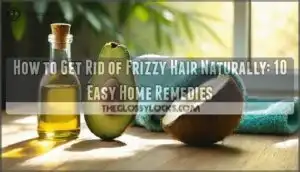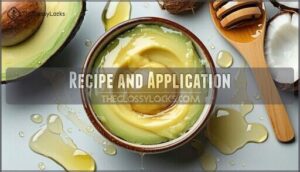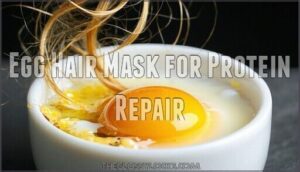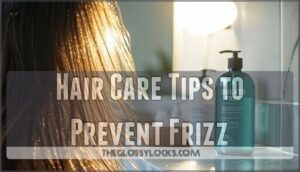This site is supported by our readers. We may earn a commission, at no cost to you, if you purchase through links.
 Taming frizz doesn’t require expensive salon treatments.
Taming frizz doesn’t require expensive salon treatments.
You can get rid of frizzy hair naturally with simple kitchen ingredients.
Apple cider vinegar rinses restore your hair’s pH balance, while coconut oil acts as a deep moisturizer when applied overnight.
Argan oil smooths wet hair before styling, and avocado masks provide intense hydration.
Switch to lukewarm water when washing, since hot water strips natural oils that keep frizz at bay.
Ditch your regular towel for a microfiber one – it’s gentler on your hair cuticles.
The secret isn’t just what you apply, but how you handle your hair daily, using these simple methods to achieve naturally beautiful hair.
Table Of Contents
- Key Takeaways
- Causes of Frizzy Hair
- How to Naturally Tame Frizzy Hair
- Try an Apple Cider Vinegar Rinse
- Benefits of Coconut Oil Treatment
- Applying Argan Oil Effectively
- Avocado Hair Mask for Deep Conditioning
- Egg Hair Mask for Protein Repair
- Hair Care Tips to Prevent Frizz
- Styling Techniques to Minimize Frizz
- Avoiding Heat Damage for Smooth Hair
- Frequently Asked Questions (FAQs)
- How to get rid of frizzy hair naturally?
- How to get frizz-free hair?
- How do you remove Frizz from hair at home?
- How do you control frizzy hair?
- Can natural frizzy hair be fixed?
- How to tame frizzy hair?
- How to stop hair from being frizzy?
- What is the best home remedy for dry frizzy hair?
- How do I permanently fix dry frizzy hair?
- How do you keep Frizz out of your hair?
- Conclusion
Key Takeaways
- You can restore your hair’s pH balance and reduce frizz by using an apple cider vinegar rinse once weekly – mix one-third cup with a quart of warm water, apply after shampooing, and let it sit for 2-3 minutes before rinsing with cool water.
- Coconut oil works as a powerful deep moisturizer when applied as an overnight mask or 30 minutes before shampooing, penetrating your hair shaft to add moisture and reduce protein loss that causes frizz.
- You’ll prevent daily frizz by switching to lukewarm water when washing, using a microfiber towel instead of regular terry cloth, and sleeping on silk pillowcases to minimize friction that roughens hair cuticles.
- Natural protein and moisture masks using kitchen ingredients like mashed avocado or beaten eggs can repair damaged hair and strengthen brittle strands when used weekly or bi-weekly, depending on your hair’s condition.
Causes of Frizzy Hair
Your hair becomes frizzy when the cuticles lift and allow moisture from humid air to enter the hair shaft, causing it to swell and separate.
Frizzy hair is simply your cuticles crying out for moisture balance and gentle care.
Damage from heat styling, harsh chemicals, and dryness weakens your hair’s protective layer, making it more prone to absorbing moisture and creating that unruly, frizzy texture you’re trying to tame.
Effects of Humidity
Humid weather transforms your hair into a frizzy nightmare through a simple yet frustrating process.
When moisture levels rise, your strands absorb water from the air, causing three key problems:
- Cuticle swelling occurs as hair porosity increases, allowing excess moisture penetration
- Seasonal frizz develops when disrupted hydrogen bonds alter your hair’s structure
- Dew point changes trigger uncontrollable volume and texture shifts
Understanding how humidity affects hair hydration helps you choose the right natural remedies for smoother results.
Damage From Static Electricity
Static buildup creates chaos when dry air strips moisture from your strands.
Material friction from synthetic brushes, wool sweaters, and plastic combs generates electrical charges that cause hair flyaways.
Your hair becomes positively charged while objects around you stay neutral, making strands repel each other like opposing magnets.
Winter frizz worsens this problem since cold air holds less moisture.
Reducing charge requires switching to natural bristle brushes and using anti-static sprays to tame frizzy hair before it gets out of control.
Impact of Hair Damage
Beyond static’s effects, damaged hair becomes frizz’s playground.
Chemical damage from harsh treatments weakens your hair cuticle, while heat styling strips essential moisture. Rough handling during brushing creates cuticle disruption, leading to protein loss that leaves strands vulnerable.
Hair damage manifests through:
- Split ends and breakage making hair unmanageable
- Dryness and brittleness inviting more frizz
- Weakened structure unable to retain moisture
How to Naturally Tame Frizzy Hair
You can tackle frizzy hair naturally by focusing on two key areas: protecting your hair from humidity and repairing existing damage.
Start by using moisture-rich treatments and pH-balancing rinses to seal your hair cuticles, then incorporate nourishing oils and masks to restore health and smoothness.
Combatting Humidity
Don’t let humidity win the frizz battle. Start your day with a leave-in conditioner containing humectant ingredients like glycerin for ideal hydration strategies.
Layer on anti-humidity sprays targeting mid-lengths and ends as your primary antifrizz remedies.
Consider protective hairstyles like braids or buns that work with climate considerations.
These natural remedies create an invisible barrier, giving you control over frizzy hair solutions regardless of weather conditions.
Addressing Hair Damage
Repairing damaged hair requires targeting the root causes of frizz. Chemical damage from coloring and heat styling weaken your hair shaft, leading to protein loss and stubborn frizz.
Here’s your hair repair action plan:
- Limit washing to 2-3 times weekly to prevent further hair breakage
- Use protein treatments monthly to restore strength and elasticity
- Trim split ends every 6-8 weeks for effective breakage prevention
Your hair will thank you.
Try an Apple Cider Vinegar Rinse
Apple cider vinegar’s slightly acidic nature helps balance your hair’s pH level, which keeps the cuticles flat and reduces frizz.
You’ll mix one-third cup of apple cider vinegar with a quart of warm water, apply it as a final rinse after shampooing, then let your hair air-dry for best results.
Preparation and Application
Getting your apple cider vinegar rinse ready is straightforward.
Mix one-third cup organic apple cider vinegar with one quart warm water—think comfortable shower temperature, not scalding hot. This Rinse Temperature matters for comfort and effectiveness.
Pour this mixture over freshly washed hair, ensuring complete coverage from roots to ends. Gently massage the solution into your scalp using fingertips, not nails.
The Application Timing is key: let it sit for two to three minutes, then rinse thoroughly with cool water.
| Step | Key Point |
|---|---|
| Mix ratio | 1/3 cup vinegar to 1 quart water |
| Water temp | Warm, not hot |
| Contact time | 2-3 minutes maximum |
| Final rinse | Cool water seals cuticles |
Frequency and Benefits
For most hair types, use this natural hair care rinse once weekly to see the best treatment benefits.
Those with dry or sensitive hair should stick to every two weeks to avoid overdoing it.
This simple rinse frequency helps restore your hair’s pH balance, reducing frizz and breakage while clarifying away product buildup.
You’ll notice improved shine and smoother texture as these natural remedies work their magic on stubborn hair frizz through proper hair hydration methods.
Benefits of Coconut Oil Treatment
Coconut oil’s high lauric acid content makes it one of the most effective natural treatments for frizzy hair, as it penetrates deep into your hair shaft to add moisture and reduce protein loss.
You can use it as a pre-wash treatment by massaging it into your hair and scalp for 15 minutes before shampooing, or apply it as an overnight mask for maximum hydration and frizz control.
Pre-wash Vs. Post-wash Use
Coconut oil timing transforms your hair frizz game completely.
Pre-wash application allows deeper product absorption, protecting strands from harsh shampoos while boosting hydration levels.
Post-wash use creates a protective barrier, enhancing treatment effectiveness against humidity.
Here’s your timing strategy:
- Pre-wash: Apply 30 minutes before shampooing for maximum penetration
- Post-wash: Use sparingly on damp hair as natural antifrizz serum
- Application timing: Massage into scalp pre-wash, focus on ends post-wash
- Frizz prevention: Choose method based on your hair’s hydration methods needs
Overnight Hair Mask
Take coconut oil treatments to the next level with an overnight hair mask. Apply coconut oil generously from mid-length to ends, focusing on damaged areas.
Wrap your hair in a soft towel or silk scarf to prevent pillow stains. This extended application technique allows deeper penetration than quick treatments.
Different hair types benefit from varying mask frequency – fine hair needs weekly sessions while thick, coarse hair can handle twice weekly.
Wake up to silky, manageable strands. It’s the ultimate DIY hair treatment using simple mask ingredients you already own.
Applying Argan Oil Effectively
You’ll get the best results from argan oil when you apply just a few drops to either wet or dry hair, focusing on the mid-lengths and ends where frizz tends to be worst.
Start with less oil than you think you need, since using too much can weigh your hair down and make it look greasy.
Wet Hair Application
Damp hair creates the ideal canvas for argan oil application, maximizing product absorption while you control hair frizz naturally.
- Dispense 2-3 drops into your palm and warm between hands
- Apply from mid-shaft to ends using gentle finger-combing motions
- Focus on even distribution through wet styling techniques
- Add extra drops for thicker hair textures
- Let natural oils for hair penetrate deeply before styling
Dry Hair Use Between Styles
Argan oil works wonders as a product refresh between wash days when your frizzy hair needs quick taming. This natural oils for hair treatment provides instant hair moisture retention and hair frizz reduction without the commitment of a full styling session.
Perfect for protective styling touch-ups, argan oil gives you control over stubborn strands while supporting scalp health.
- Apply 2-3 drops to avoid weighing down your style
- Focus on mid-lengths and ends where dry hair shows most
- Warm oil between palms before oil application
- Skip roots to prevent greasiness near your scalp
- Keep travel-size bottles handy for hydration methods on-the-go
Avocado Hair Mask for Deep Conditioning
You’ll love how avocado’s natural vitamins A and E transform dry, frizzy hair into silky strands.
This creamy fruit creates an incredibly nourishing mask that penetrates deep into your hair shaft, providing the intense moisture your damaged cuticles desperately need, with its natural vitamins A and E being particularly transformative.
Recipe and Application
Making your own avocado hair mask is simpler than you’d think. Mash one ripe avocado until completely smooth, then blend in 2-4 tablespoons of coconut oil to create the perfect creamy consistency.
This DIY hair treatment works best when you start at the roots and work through every strand methodically. For ingredient variations, try adding honey or olive oil to boost moisture.
Cover with a shower cap after application to lock in the natural hair remedies. The mask consistency should be thick enough to coat hair without dripping everywhere, using the right amount of coconut oil for the perfect DIY hair treatment.
How Often to Use
Finding the right mask frequency for your avocado treatment depends on your hair’s unique needs and current condition.
Here’s how to time your hair treatment frequency for ideal results:
- Weekly applications work best for dry, damaged, or chemically-treated hair that craves intense moisture
- Bi-weekly treatments suit normal hair types that need moderate conditioning support
- Monthly sessions are perfect for naturally oily hair that requires lighter maintenance
Your hair care routine should adapt to seasonal changes too.
Winter’s harsh conditions often call for more frequent natural hair remedies, while summer humidity might require less intensive product usage to avoid weighing down your strands.
Egg Hair Mask for Protein Repair
When your hair’s feeling damaged and weak, an egg mask can rebuild its protein structure from the inside out.
You’ll strengthen brittle strands and reduce frizz by applying this protein-rich treatment once or twice weekly.
Basic Egg Mask
Egg mask benefits shine through this simple DIY egg mask recipe.
Whip two fresh eggs until frothy, creating a protein-packed treatment for damaged strands.
Apply the mixture from roots to tips using gentle mask application tips.
Cover with a shower cap and wait 15 minutes.
Use cool water for rinse-out methods to prevent cooking the eggs.
This homemade hair mask strengthens brittle, frizzy hair effectively.
Egg With Oil Variation
Adding natural oils to your basic egg mask creates a powerhouse hair treatment that tackles frizz from multiple angles.
The Egg-Oil Benefits are clear – protein repairs while oils seal moisture.
- Oil Type Matters: Choose coconut oil for deep penetration or argan oil for lightweight conditioning
- Application Techniques: Focus on mid-lengths and ends where frizz appears most
- Mask Frequency: Use weekly for damaged hair, biweekly for maintenance
- Hair Type: Adjust oil quantity based on thickness and porosity
Hair Care Tips to Prevent Frizz
The products you choose can make or break your fight against frizz, so selecting the right shampoo and conditioner is essential for smooth, manageable hair.
You’ll want to focus on sulfate-free formulas that hydrate rather than strip your hair’s natural oils, while proper conditioning techniques help seal the cuticle and lock out humidity to achieve smooth hair.
Choosing The Right Shampoo
After your protein-packed egg treatment, choosing the right shampoo becomes your frizz-fighting foundation.
Sulfate-free benefits include preserving natural oils while maintaining proper hair pH balance. You can find a sulfate free option to suit your needs.
| Hair Type | Best Shampoo Choice |
|---|---|
| Dry/Damaged | Glycerin shampoo with argan oil |
| Oily | Clarifying sulfatefree formula |
| Curly | Hydrating ingredients like shea butter |
| Color-treated | Gentle frizz control formulas |
Pick hydrating ingredients that match your specific hair type for effective hair grease removal without overdrying.
Importance of Conditioning
Think of conditioning as your hair’s daily dose of armor against frizz.
After every shampoo, work conditioner through your mid-lengths to ends where damage loves to hide.
Different conditioner types serve unique purposes – lightweight formulas for fine hair, rich creams for coarse textures.
Master proper application techniques by sectioning damp hair and distributing product evenly.
Rinse with cool water to seal cuticles.
Deep conditioning weekly provides intense hair nourishment, while leave-in benefits include ongoing protection and hair smoothing between washes.
Styling Techniques to Minimize Frizz
The way you dry and style your hair can make or break your fight against frizz, and small changes in your routine will create noticeable results.
Simple swaps like using microfiber towels instead of regular terry cloth and sleeping on silk pillowcases can dramatically reduce friction and help you wake up with smoother, more manageable hair.
Drying Hair With Microfiber Towels
Your cotton towel creates friction that roughens hair cuticles and worsens hair frizz.
Microfiber towel benefits include gentler drying and superior frizz reduction compared to regular towel material.
This advanced hair drying technique cuts drying time while protecting hair texture. Gently squeeze excess water, then wrap hair in microfiber fabric for ten minutes.
Many brands offer various microfiber options for different hair types.
Your improved hair care routine starts with smarter hair health choices.
Silk Pillowcase Benefits
Your microfiber towel routine sets the foundation, but your silk pillowcase delivers the finishing touch for frizz reduction overnight.
This luxurious upgrade transforms your hair care game while you sleep.
Here’s how silk pillowcases promote hair health and reduced breakage:
- Minimize friction – Silk’s smooth surface prevents hair smoothing techniques from unraveling, maintaining your style longer
- Retain moisture – Unlike cotton, silk doesn’t absorb your hair’s natural oils, supporting skin hydration
- Regulate temperature – Cool silk surface reduces overnight sweating that triggers frizzy hair
Avoiding Heat Damage for Smooth Hair
Heat styling tools damage your hair’s cuticle, making frizz worse and harder to control naturally.
You can protect your strands by using heat protectant products before styling and limiting how often you reach for blow dryers, flat irons, and curling tools.
Using Heat Protectants
Heat protectants act as your hair’s bodyguard against styling damage and hair frizz. These products create a protective barrier that reduces heat absorption by up to 50%, keeping your strands healthier during heat styling.
You can find a variety of options online.
Application Techniques matter most – apply to damp hair before any hot tool use.
Product Types vary by hair needs:
Hair Type Best Protectant Heat Settings Key Benefit
Ingredient Efficacy depends on silicones and polymers that distribute heat evenly, minimizing Long-Term Effects of thermal damage on frizzy hair.
Reducing Hot Tool Usage
Why rely on damaging heat styling when you can embrace your natural texture?
Air drying prevents hair damage while maintaining healthy strands.
Try heatless styling methods like overnight braids or foam rollers for gorgeous waves without the burn.
When you must use tools, choose low-heat tools and lower temperature settings.
These protective styles offer effective hair frizz prevention, letting you style confidently while prioritizing hair protection over quick fixes.
Frequently Asked Questions (FAQs)
How to get rid of frizzy hair naturally?
Coincidentally, your kitchen holds frizz-fighting treasures.
Apply coconut oil for fifteen minutes before shampooing, rinse with diluted apple cider vinegar, or create avocado masks.
These natural remedies restore moisture and smooth your hair’s cuticle effectively.
How to get frizz-free hair?
You’ll achieve frizz-free hair by using sulfate-free shampoo, applying leave-in conditioner to damp hair, and sealing cuticles with cold water rinses.
Try coconut oil masks weekly and avoid heat styling when possible.
How do you remove Frizz from hair at home?
Your kitchen holds the secret to taming unruly strands.
Mix coconut oil with honey, apply for twenty minutes, then rinse.
Try apple cider vinegar diluted in water as a final rinse to seal cuticles and lock in smoothness.
How do you control frizzy hair?
You’ll control frizzy hair by using sulfate-free shampoos, applying leave-in conditioners to damp hair, sealing cuticles with cold water rinses, and protecting strands from humidity with anti-frizz serums or oils.
Can natural frizzy hair be fixed?
Natural frizzy hair can’t be "fixed" permanently since it’s your hair’s natural texture.
But you can definitely manage and smooth it using moisturizing treatments, proper products, and gentle styling techniques to reduce frizz substantially.
How to tame frizzy hair?
You can tame frizzy hair by using sulfate-free shampoos.
Applying leave-in conditioners to damp hair.
Sealing cuticles with cold water rinses.
And incorporating weekly deep conditioning masks with natural oils like coconut or argan.
How to stop hair from being frizzy?
Like untamed wildfire, frizzy hair rebels against your morning routine.
You’ll conquer frizz by using sulfate-free shampoo.
Applying coconut oil masks weekly, and sealing cuticles with cold water rinses to lock in moisture permanently.
What is the best home remedy for dry frizzy hair?
Coconut oil works wonders as an overnight mask. Apply it generously, focusing on damaged areas, then shampoo out. You’ll notice softer, more manageable hair that’s less prone to frizzing up.
How do I permanently fix dry frizzy hair?
You can’t permanently fix frizzy hair, but consistent deep conditioning, using sulfate-free products, protecting from heat damage, and maintaining proper hydration will substantially reduce frizz and keep your hair manageable long-term.
How do you keep Frizz out of your hair?
Use sulfate-free shampoo, apply leave-in conditioner to damp hair, and seal cuticles with cold water rinses.
Choose products with argan oil or coconut oil, avoid heat styling, and sleep on silk pillowcases to maintain smooth strands, using techniques like these can help keep your hair healthy and strong with coconut oil.
Conclusion
Beautiful hair doesn’t require breaking the bank or harsh chemicals.
These natural remedies prove that learning how to get rid of frizzy hair naturally is achievable with pantry staples.
From apple cider vinegar rinses to overnight coconut oil treatments, you’ve discovered ten effective methods to transform your locks.
Remember, consistency matters more than perfection.
Start with one or two techniques that appeal to you, then gradually incorporate others.
Your hair will thank you for choosing gentle, natural solutions over expensive salon alternatives, and for taking the time to find what works best for you, using natural remedies.














